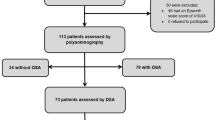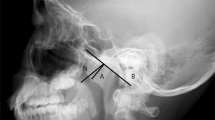Abstract
Objective:
To investigate the impacts of body weight status on surgical outcomes and shifts of body weight status after adenotonsillectomy(T&A) in children with obstructive sleep apnea (OSA).
Methods:
From 2009 to 2011, 161 children (mean age, 7.0±3.4 years; 78% boys) were included. All the children had clinical symptoms and preoperative polysomnographic evaluations diagnosis of OSA. Children were divided into four weight status groups (underweight, normal weight, overweight and obese), based on age and gender corrected body mass index (BMI).
Results:
Following T&A, the four different weight status groups significantly improved in apnea/hypopnea index (AHI) and minimum oxygen saturation. However, 49.1% of the children (79/161) had residual OSA (AHI ⩾1). The incidence of residual OSA (AHI ⩾1) in the obese group was 75%, which was significantly higher than the other three groups (P<0.01). Weight status changes after T&A were documented, and 54% (13/24) of the underweight children shifted to normal weight status within 6 months after surgery.
Conclusion:
Although sleep parameters improved in all weight statuses, obese children had a higher incidence of residual OSA postoperatively. About half of the underweight children shifted to normal weight status after T&A.
This is a preview of subscription content, access via your institution
Access options
Subscribe to this journal
Receive 12 print issues and online access
$259.00 per year
only $21.58 per issue
Buy this article
- Purchase on Springer Link
- Instant access to full article PDF
Prices may be subject to local taxes which are calculated during checkout

Similar content being viewed by others
References
American Thoracic Society. Standards and indications for cardiopulmonary sleep studies in children. Am J Respir Crit Care Med 1996; 153: 866–878.
Schechter MS . Technical report: diagnosis and management of childhood obstructive sleep apnea syndrome. Pediatrics 2002; 109: e69.
Amin RS, Carroll JL, Jeffries JL, Grone C, Bean JA, Chini B et al. Twenty-fourhour ambulatory blood pressure in children with sleep-disordered breathing. Am J Respir Crit Care Med 2004; 169: 950–956.
Chervin RD, Dillon JE, Bassetti C, Ganoczy DA, Pituch KJ . Symptoms of sleep disorders, inattention, and hyperactivity in children. Sleep 1997; 20: 1185–1192.
Nieminen P, Löppönen T, Tolonen U, Lanning P, Knip M, Löppönen H . Growth and biochemical markers of growth in children with snoring and obstructive sleep apnea. Pediatrics 2002; 109: e55.
Brietzke SE, Gallagher D . The effectiveness of tonsillectomy and adenoidectomy in the treatment of pediatric obstructive sleep apnea/hypopnea syndrome: a meta-analysis. Otolaryngol Head Neck Surg 2006; 134: 979–984.
Friedman M, Wilson M, Lin HC, Chang HW . Updated systematic review of tonsillectomy and adenoidectomy for treatment of pediatric obstructive sleep apnea/hypopnea syndrome. Otolaryngol Head Neck Surg 2009; 140: 800–808.
Capdevila OS, Kheirandish-Gozal L, Dayyat E, Gozal D . Pediatric obstructive sleep apnea: complications, management, and long-term outcomes. Proc Am Thorac Soc 2008; 5: 274–282.
Kang KT, Lee PL, Weng WC, Hsu WC . Body weight status and obstructive sleep apnea in children. Int J Obes (Lond) 2012; 36: 920–924.
Costa DJ, Mitchell R . Adenotonsillectomy for obstructive sleep apnea in obese children: a meta-analysis. Otolaryngol Head Neck Surg 2009; 140: 455–460.
Marcus CL, Carroll JL, Koerner CB, Hamer A, Lutz J, Loughlin GM . Determinants of growth in children with the obstructive sleep apnea syndrome. J Pediatr 1994; 125: 556–562.
Tauman R, Gulliver TE, Krishna J, Montgomery-Downs HE, O’Brien LM, Ivanenko A et al. Persistence of obstructive sleep apnea syndrome in children after adenotonsillectomy. J Pediatr 2006; 149: 803–808.
Bonuck KA, Freeman K, Henderson J . Growth and growth biomarker changes after adenotonsillectomy: systematic review and meta-analysis. Arch Dis Child 2009; 94: 83–91.
Major MP, Flores-Mir C, Major PW . Assessment of lateral cephalometric diagnosis of adenoid hypertrophy and posterior upper airway obstruction: a systematic review. Am J Orthod Dentofacial Orthop 2006; 130: 700–708.
Brodsky L, Moore L, Stanievich JF . A comparison of tonsillar size and oropharyngeal dimensions in children with obstructive adenotonsillar hypertrophy. Int J Pediatr Otorhinolaryngol 1987; 13: 149–156.
Chen W, Chang MH . New growth charts for Taiwanese children and adolescents based on World Health Organization standards and health-related physical fitness. Pediatr Neonatol 2010; 51: 69–79.
Lee P, Su YN, Yu CJ, Yang PC, Wu HD . Phox2b mutation-confirmed congenital central hypoventilation syndrome in a chinese family: presentation from newborn to adulthood. Chest 2009; 135: 537–544.
Iber C, Ancoli-Israel S, Chesson AL, Quan SF . The AASM Manual for the scoring of sleep and associated events. American Academy of Sleep Medicine: Darien, IL, 2007.
Bhattacharjee R, Kheirandish-Gozal L, Spruyt K, Mitchell RB, Promchiarak J, Simakajornboon N et al. Adenotonsillectomy outcomes in treatment of obstructive sleep apnea in children: a multicenter retrospective study. Am J Respir Crit Care Med 2010; 182: 676–683.
Alexiou VG, Salazar-Salvia MS, Jervis PN, Falagas ME . Modern technology-assisted vs conventional tonsillectomy: a meta-analysis of randomized controlled trials. Arch Otolaryngol Head Neck Surg 2011; 137: 558–570.
O’Brien LM, Sitha S, Baur LA, Waters KA . Obesity increases the risk for persisting obstructive sleep apnea after treatment in children. Int J Pediatr Otorhinolaryngol 2006; 70: 1555–1560.
Mitchell RB, Kelly J . Outcome of adenotonsillectomy for obstructive sleep apnea in obese and normal-weight children. Otolaryngol Head Neck Surg 2007; 137: 43–48.
Mitchell RB, Boss EF . Pediatric obstructive sleep apnea in obese and normal-weight children: impact of adenotonsillectomy on quality-of-life and behavior. Dev Neuropsychol 2009; 34: 650–661.
Mitchell RB . Adenotonsillectomy for obstructive sleep apnea in children: outcome evaluated by pre- and postoperative polysomnography. Laryngoscope 2007; 117: 1844–1854.
Ye J, Liu H, Zhang GH, Li P, Yang QT, Liu X et al. Outcome of adenotonsillectomy for obstructive sleep apnea syndrome in children. Ann Otol Rhinol Laryngol 2010; 119: 506–513.
Bate TW, Price DA, Holme CA, McGucken RB . Short stature caused by obstructive apnoea during sleep. Arch Dis Child 1984; 59: 78–80.
Everett AD, Koch WC, Saulsbury FT . Failure to thrive due to obstructive sleep apnea. Clin Pediatr (Phila) 1987; 26: 90–92.
Brouillette RT, Fernbach SK, Hunt CE . Obstructive sleep apnea in infants and children. J Pediatr 1982; 100: 31–40.
Schiffmann R, Faber J, Eidelman AI . Obstructive hypertrophic adenoids and tonsils as a cause of infantile failure to thrive: reversed by tonsillectomy and adenoidectomy. Int J Pediatr Otorhinolaryngol 1985; 9: 183–187.
American Academy of Pediatrics. Clinical practice guideline: diagnosis and management of childhood obstructive sleep apnea syndrome. Section on pediatric pulmonology, subcommittee on obstructive sleep apnea syndrome. Pediatrics 2002; 109: 704–712.
Bonuck K, Parikh S, Bassila M . Growth failure and sleep disordered breathing: a review of the literature. Int J Pediatr Otorhinolaryngol 2006; 70: 769–778.
Black MM, Dubowitz H, Krishnakumar A, Starr RH . Early intervention and recovery among children with failure to thrive: follow-up at age 8. Pediatrics 2007; 120: 59–69.
Darrow DH, Siemens C . Indications for tonsillectomy and adenoidectomy. Laryngoscope 2002; 112: 6–10.
Mitchell RB, Kelly J . Outcome of adenotonsillectomy for severe obstructive sleep apnea in children. Int J Pediatr Otorhinolaryngol 2004; 68: 1375–1379.
Mitchell RB, Kelly J . Outcome of adenotonsillectomy for obstructive sleep apnea in children under 3 years. Otolaryngol Head Neck Surg 2005; 132: 681–684.
Wang RC, Elkins TP, Keech D, Wauquier A, Hubbard D . Accuracy of clinical evaluation in pediatric obstructive sleep apnea. Otolaryngol Head Neck Surg 1998; 118: 69–73.
Bar A, Tarasiuk A, Segev Y, Phillip M, Tal A . The effect of adenotonsillectomy on serum insulin-like growth factor-I and growth in children with obstructive sleep apnea syndrome. J Pediatr 1999; 135: 76–80.
Kiris M, Muderris T, Celebi S, Cankaya H, Bercin S . Changes in serum IGF-1 and IGFBP-3 levels and growth in children following adenoidectomy, tonsillectomy or adenotonsillectomy. Int J Pediatr Otorhinolaryngol 2010; 74: 528–531.
Hashemian F, Farahani F, Sanatkar M . Changes in growth pattern after adenotonsillectomy in children under 12 years old. Acta Med Iran 2010; 48: 316–319.
Soultan Z, Wadowski S, Rao M, Kravath RE . Effect of treating obstructive sleep apnea by tonsillectomy and/or adenoidectomy on obesity in children. Arch Pediatr Adolesc Med 1999; 153: 33–37.
Acknowledgements
We thank Staff of the Center of Sleep Disorder, National Taiwan University Hospital for their technical support.
Author information
Authors and Affiliations
Corresponding author
Ethics declarations
Competing interests
The authors declare no conflict of interest.
Additional information
Presented at the 11th International Congress of the European Society of Pediatric Otorhinolaryngology (ESPO2012), Amsterdam, 20-23 May, 2012.
Rights and permissions
About this article
Cite this article
Hsu, WC., Kang, KT., Weng, WC. et al. Impacts of body weight after surgery for obstructive sleep apnea in children. Int J Obes 37, 527–531 (2013). https://doi.org/10.1038/ijo.2012.194
Received:
Revised:
Accepted:
Published:
Issue Date:
DOI: https://doi.org/10.1038/ijo.2012.194
Keywords
This article is cited by
-
Management of Pediatric OSA Beyond Adeno-Tonsillectomy
Current Sleep Medicine Reports (2017)
-
The relation between childhood obesity and adenotonsillar hypertrophy
European Archives of Oto-Rhino-Laryngology (2016)
-
Effects of adenotonsillectomy on plasma inflammatory biomarkers in obese children with obstructive sleep apnea: A community-based study
International Journal of Obesity (2015)
-
Central sleep apnea in obese children with sleep-disordered breathing
International Journal of Obesity (2014)



